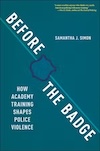Almost four years have passed since George Floyd was killed outside of a convenience store by then-Minneapolis police officer Derek Chauvin. Video footage of the killing spread like wildfire, showing Floyd lying handcuffed, unmoving while Chauvin’s knee pressed into his neck for over nine minutes. In the months that followed, the American public took to the streets to express their anger, grief, and frustration, and to collectively demand changes to the police institution.

Before the Badge: How Academy Training Shapes Police Violence
Samantha J. Simon
NYU Press
March, 2024
In 2018, two years before Floyd was killed, I was in the middle of an in-depth study of police academy training. During that year, I spent close to 600 hours participating in and observing cadets as they underwent training to be police officers. As much as possible, I trained alongside the cadets, lifting weights, running in formation, learning defensive tactics, and shooting guns. I spent long days learning about the code of criminal procedure, traffic code, and arrest procedures.
I also had a first-row seat to the cadets’ physical, ideological, and emotional transformations as, over a period of six to eight months, they became police officers. What I saw in that year directly conflicted with the “bad apple” arguments that existed then and that would continue to offer a popular explanation for police violence just a few years later in the summer of 2020 and beyond.
At the academies I studied, the cadets were socialized into a system of state violence, where the organization itself required an alignment with a worldview that emphasized the use of violence, discretely encouraged racial profiling, and mandated a competence in (and arguably eagerness to use) violence. I outline this process in my upcoming book, Before the Badge: How Academy Training Shapes Police Violence, from the initial process of cadet selection, through the academic and tactical training, until graduation, when cadets officially become new police officers.
At these academies, cadets were encouraged to adopt a warrior approach to their new jobs. Instructors warned cadets to be wary of others, constantly prepared for violence, and especially suspicious of certain kinds of people. New cadets were told that police officers were in more danger now than ever before, and that bad guys wanting to hurt and kill them could be lurking around every corner. Despite the fact that policing has not gotten more dangerous over time, graphic videos of officers being brutally beaten and killed were shown in nearly every class I attended, bringing these warnings to life for these officers in training. An important part of adopting a warrior approach was learning how to identify their enemy, a process that was decidedly racialized.
Although instructors never outright encouraged cadets to profile Black and Latino communities, they did use thinly veiled, coded language to do just that. In a tactical class at one academy, for example, instructors suggested that although cadets might not need to frisk a mother crossing the street with her kids, they should frisk a man wearing all red in the Southeastern part of the city (where most of the city’s Black and Latino population lived). Instructors often encouraged cadets to profile based on what they called “criminality”—referencing clothing, location, type of car, or even their gait in the process—instead of race and ethnicity, insisting that an ability to profile “criminality” was a key part of their jobs.
If a cadet would not (or could not) adapt to the expectations of the academy, they did not make it to graduation. These cadets either voluntarily chose to leave or were removed by their supervisors. This happened, for example, with a man I’ll call Adam, who was essentially fired just a few days before graduation. Despite being White, blond, and above average height, Adam had trouble embodying the hypermasculine ideals of the institution. He wasn’t particularly athletic or muscular, and his instructors often made fun of his lanky figure, his unique vocabulary, and his slow, methodical manner of speech. Mostly, though, his instructors mocked Adam for being physically weak and bad at fighting.
In an interview a few months after he had been fired, Adam described feeling like he had a target on his back while at the academy. Ultimately, he said, he couldn’t “punch hard enough to make [the instructors] shut up about it.” The “environment” at the academy, he added, was “more focused on your ability to punch the problem,” which conflicted with the image of a police officer he’d had in mind when he first entered the academy.
Adam’s instructors often set him up to be publicly humiliated during his training. Once, for example, they purposely paired him up with one of the top cadets in the class, who had undergone Navy SEAL training and weighed at least 70 pounds more than Adam, to fight in a mud pit. “I had spaghetti arms by the time we were done,” Adam recalled. Adam was not a good fit for policing because he did not engage in the kind of violence the institution demanded. Adam’s classmates who did make it through the academy were those who successfully aligned themselves with the institution’s existing culture—one steeped in violence.
Through the selection and training of new cadets the policing institution ensures that only those who would fit into the existing culture make it in, and then make it to graduation. Although cadets who aren’t White men face unique challenges in the academy, all cadets, regardless of their race and gender, are required to align themselves with this approach to policing in order to get and keep their jobs. This isn’t an issue of bad, violent, racist officers sneaking their way into policing, it’s a system of socialization imposed and maintained by the organization itself. In other words, the apple tree itself is rotten.


